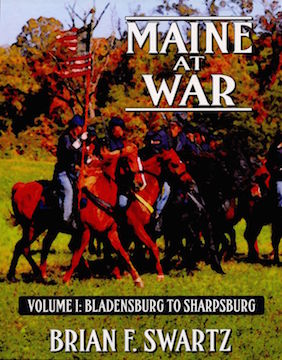Recent Book Begins to Trace the Path of Maine at War
 by ECW Correspondent Meghan Hall
by ECW Correspondent Meghan Hall
Over the course of several years, Brian Swartz’s research led him to realize that his home state of Maine had been underappreciated in larger narratives about the Civil War, despite the wealth of meticulous records he encountered. In order to better present Maine’s important role in the conflict, Swartz decided to publish a series of books, Maine at War, which he hopes will engage a new audience and increase public understanding of Civil War history as it affected the North.
Swartz covered between 10,000 and 20,000 miles of ground while researching for his newly released first volume, Maine at War Volume I: Bladensburg to Sharpsburg. He scoured archives, piecing together the lives of Mainers, as well as their involvements in the Civil War. The book, released on May 1 by Epic Saga Publishing of Brewer, Maine, is a culmination of nearly three years of research and writing, though Swartz said that some of the research dates back to 2011.

Swartz, a former reporter and editor for the Bangor Daily News, used to write a column in the newspaper titled “Maine at War,” which began in April 2011, around the time of the Civil War sesquicentennial. “I transitioned the column to a weekly blog in March 2012,” said Swartz. For two years, Swartz continued to update the blog weekly—and still does. However, in July 2014, he began writing Volume I of the Maine at War books, which he intends as the first book in a trilogy.
Swartz used a unique approach when writing his book, which sets it apart from many others published about the Civil War. “I focused on…particular individuals who left a large paper trail, in the sense of letters, memoirs, newspaper articles and to some extent, the regimental officers in the official records,” he said. Rather than simply presenting fact-based evidence to his readers, Swartz personalizes the people who were part of the war. He refers to these people as “characters,” in the book, telling their individual stories within the context of the battles and political turmoil. He said this offers readers the chance to follow the story of specific people’s lives, while also understanding their impact on the Union army.
Swartz said that his approach to writing Volume I is partly attributable to his career in reporting, while also partly attributable to the fact that he prefers individual stories to general, overarching ones. He said that Volumes II and III will follow a similar pattern, though they may introduce some new historical figures and lose some from Volume I.
Swartz explained that some of his interest in the Civil War came from the education system in Maine.
“I grew up in Brewer, Maine, on Chamberlain Street, which is named after the Chamberlain family. All we’d ever been taught, and all that my three children were taught, in school was that Joshua Chamberlain and the Twentieth Maine infantry regiment saved the Union Line at Little Round Top, and so they saved the Union,” said Swartz. “When I started researching…I quickly discovered there’s a wealth of material out there. I have found more sources than I could possibly publish, probably in a lifetime, as far as the involvement of other Mainers in the war.”
Swartz said he particularly enjoyed moving past the idea that Chamberlain and the Twentieth Maine were the only pertinent Mainers involved in the Civil War. “One of the main characters in the book is the Maine Adjutant General. His name was John Hodsdon, Jr…. His staff basically ran the war effort on the Maine end of things during the war,” said Swartz. “He stepped down in 1866, but he saved everything.”
Because there were not any land battles fought in Maine in the Civil War, it is one state often overlooked when analyzing the rich history of the Civil War and the Union army. However, Swartz explained that Mainers’ spirit was one of the main reasons that Maine’s soldiers, and women and men on the home front, were committed and fierce. He said, “When the Civil War started, many Mainers…had a patriotic, almost combative, attitude, even though they were not trained soldiers. I explain [in the book] how the state transitioned from a peacetime footing to a wartime footing.”
He said major characters in the book go beyond the men who fought in the war, extending to women on the home front who sewed and provided food, also encompassing women who joined the war as volunteer nurses. He said that much of the research for these “characters” came from the Maine State Archives.
Swartz said he has done several speaking engagements on Maine at War Volume I and noted that he has more coming up in August.
As per Swartz, a few hundred copies of the book have been sold already, and readers are enjoying the immersive experience Maine at War Volume I offers them.
“I’m told by readers who have contacted me,” said Swartz, “that they’ve enjoyed the book [and] learned quite a bit about Mainers and the Civil War.”